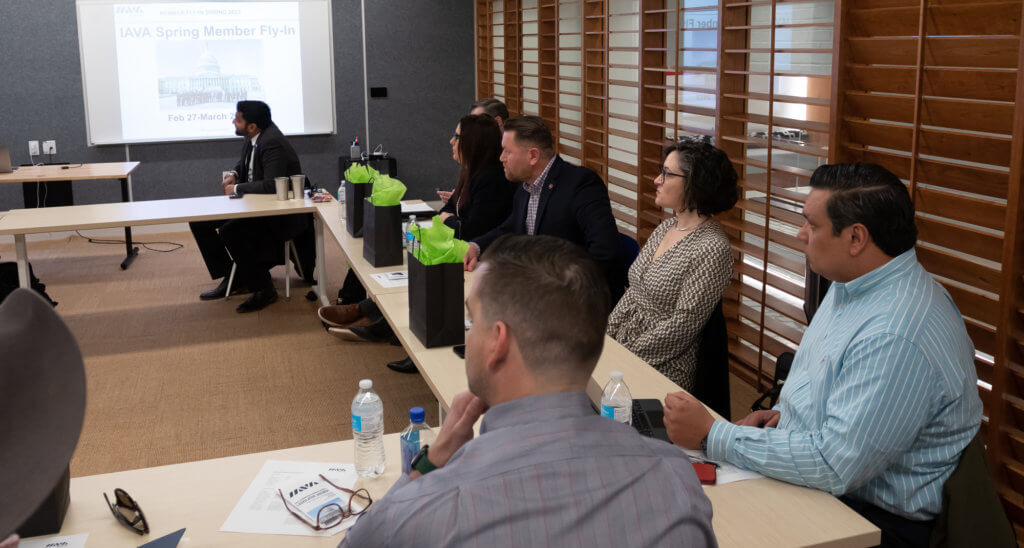At the height of the wars in Afghanistan and Iraq, as many as half the U.S. service members deployed at a given time were drawn from National Guard or Reserve forces. It comes as little surprise, then, that when Iraq and Afghanistan Veterans of America (IAVA) launched its All-Star Advocacy Fly-In on Capitol Hill on Monday, it included several reserve component veterans.
With more than 425,000 members, IAVA is the nation’s leading veterans service organization that focuses on veterans from the post-9/11 conflicts. Its annual Fly-In event, known formerly as “Storm the Hill,” brings about 20 IAVA members from across the nation to the halls of power in Washington for a week of lawmaker staff engagements, advocacy training and congressional hearings. The hope is the experience will inspire a passionate core to further their advocacy work at home, or possibly, pursue advocacy as their life’s work.
“Over the years, some have joined the staff of IAVA and other national [veteran service organizations], some have joined congressional staff and the administration, some have run for office,” said IAVA CEO Jeremy Butler during a March 1 joint hearing of the House and Senate Veterans Affairs Committees.
According to its most recent member survey, 61% of IAVA members are serving or previously served in the National Guard or reserves. One of those members, Natalie Lupiani, came to Capitol Hill eager to engage policymakers about issues impacting female veterans.
“The cultural issue of really recognizing women veterans is an important and meaningful start,” said Lupiani, an Air Guard veteran who now works as a pollster and strategic consultant. “I know how much words really do matter. Updating the VA’s motto to make it more inclusive is a very important first step in changing perceptions and the culture.”
Lupiani’s views are in keeping with IAVA’s #SheWhoBorneTheBattle campaign, an effort to bridge the gaps for female veterans’ health care and change the VA’s motto, which includes “To care for him who shall have borne the battle and for his widow, and his orphan,” a quote from President Lincoln’s second inaugural address. The motto, IAVA maintains, only furthers the perception that VA health care – and the wider veteran community – is a male-dominated space.
“The VA needs to do quite a bit more to ensure women veterans can rely on them for their health care, just as male veterans have for decades,” said Lupiani, a military sexual trauma survivor. “Many women veterans won’t step foot in a VA hospital because it’s a fearful place for them … Currently, there is a big disconnect between the number of female veterans and the lack of VA providers who genuinely understand women’s concerns.”
RELATED: Presumed sick? Burn pit legislation receives bipartisan support
Lupiani’s passion for modernizing the VA and advocating for female veterans mirrors two of the IAVA’s “Big 6” priorities. The others include addressing toxic exposure related to burn pits, strengthening education benefits, advancing alternative therapies such as cannabis and MDMA, and combatting the veteran suicide crisis.
“The most important issue for me is veteran suicide,” said Joseph Somosky, an Army Guard veteran who joined Lupiani and others for this year’s Fly-In. “It’s a very personal issue for me because three of my soldiers took their lives. I try to live my life in a way that honors them and motivates me to keep advocating.”
Somosky, who works in law enforcement in Colorado, said suicide prevention should be rooted in connecting veterans with resources, whether through VA, VSOs like the VFW or American Legion, or community health agencies. VA studies indicate that when veterans experiencing suicidal ideations receive mental health care, the rate of acting on suicidal thoughts plummets compared to those who don’t access care.
“There are a lot of resources and sometimes they are overlapping, but the key is connecting them to the resource that is a good fit for them,” said Somosky, while acknowledging the National Guard and reserves pose special challenges for leaders. “It’s unique in that you don’t see your soldier every day and you’re often geographically spread out, so there’s a disconnect. … But I’m a believer in action over words, and being here with the leaders on Capitol Hill, it means a lot to be able to engage with them and do the work of advocacy.”
Butler, who serves as a Surface Warfare Office in the Navy Reserve in addition to his role as IAVA CEO, said wars are expensive and don’t stop when service members return home.
“As we have often said at IAVA, “if you don’t like paying the cost of benefits for veterans, stop creating more of us,’” Butler said.
For more information, or to learn more about IAVA’s priorities, visit its website.
If you are a veteran in need of mental health assistance, call the Veterans Crisis Line. Dial 988 and Press 1.

